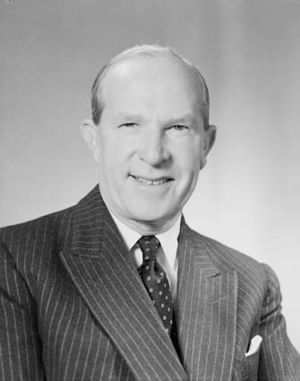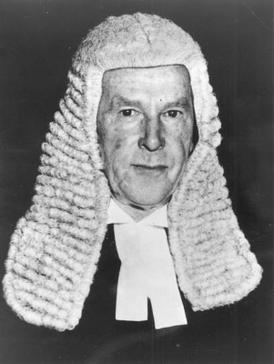Garfield Barwick facts for kids
Quick facts for kids
Garfield Barwick
|
|
|---|---|

Barwick in 1959
|
|
| 7th Chief Justice of Australia | |
| In office 27 April 1964 – 11 February 1981 |
|
| Nominated by | Sir Robert Menzies |
| Appointed by | William Philip Sidney, 1st Viscount De L'Isle |
| Preceded by | Sir Owen Dixon |
| Succeeded by | Sir Harry Gibbs |
| Attorney-General of Australia | |
| In office 12 October 1958 – 4 March 1964 |
|
| Prime Minister | Robert Menzies |
| Preceded by | Neil O'Sullivan |
| Succeeded by | Billy Snedden |
| Minister for External Affairs | |
| In office 22 December 1961 – 24 April 1964 |
|
| Prime Minister | Robert Menzies |
| Preceded by | Robert Menzies |
| Succeeded by | Paul Hasluck |
| Member of the Australian Parliament for Parramatta |
|
| In office 8 March 1958 – 24 April 1964 |
|
| Preceded by | Howard Beale |
| Succeeded by | Nigel Bowen |
| Personal details | |
| Born | 22 June 1903 Sydney, New South Wales, Australia |
| Died | 13 July 1997 (aged 94) Sydney, New South Wales, Australia |
| Resting place | Northern Suburbs Memorial Gardens |
| Political party | Liberal |
| Spouse |
Norma Symons
(m. 1929) |
| Education | Fort Street High School |
| Alma mater | University of Sydney |
Sir Garfield Edward John Barwick (born 22 June 1903 – died 13 July 1997) was an important Australian judge and politician. He served as the seventh and longest-serving Chief Justice of Australia from 1964 to 1981. Before that, he was a politician for the Liberal Party. He worked as a minister in the government led by Robert Menzies from 1958 to 1964.
Barwick was born in Sydney, Australia. He went to Fort Street High School and then studied law at the University of Sydney. In 1927, he became a barrister, which is a type of lawyer who argues cases in court. He became one of Australia's most famous barristers, working on many big cases, often in the High Court. He also led the NSW Bar Association and the Law Council of Australia.
He started his political career when he was 54 years old. He was elected to the House of Representatives in 1958. Soon after, Prime Minister Robert Menzies made him the Attorney-General. In 1961, he also became the Minister for External Affairs.
In 1964, Menzies chose Barwick to become the Chief Justice of the High Court. For the next 17 years, the High Court, under Barwick's leadership, made many important decisions about Australia's laws. He also played a small but important part in the 1975 Australian constitutional crisis. He advised the Governor-General, Sir John Kerr, that he had the power to remove Prime Minister Gough Whitlam from office. Barwick retired from the court at 77 but remained a public figure until he passed away at 94. He was also the first president of the Australian Conservation Foundation.
Contents
Early Life and Education
Garfield Barwick was one of three brothers. His parents were Methodist and had Cornish family roots. He often spoke proudly of his Cornish background. He grew up in Stanmore, a suburb in Sydney. He attended Fort Street High School. He later graduated from the University of Sydney with top honors in law.
Becoming a Lawyer
Barwick was a very dedicated student. He started working as a lawyer soon after finishing university. He faced some financial difficulties during the Great Depression. Despite these challenges, he became a successful barrister in 1927. He gained a lot of respect from others in the legal field.
During World War II, Barwick became very well-known. He challenged the National Security Act 1939, which gave the Australian government more power. His arguments helped him become a leading lawyer.
He also became famous in 1943 during a case about a painting. The case was about whether William Dobell's portrait of Joshua Smith was a real portrait or a cartoon. Barwick represented the person who sued. Even though they lost, the judges praised his brilliant arguments. This made his name widely known.
He worked on many important cases about Australia's laws, like the "Airlines case" and the "Bank Nationalisation case." Because of his great work, he was made a knight in 1953.
One famous story shows how clever he was. Thirteen people from Malaysia who were sentenced to death appealed to the Privy Council. Twelve of them hired Barwick. He found a small mistake in their arrest warrants and got them all freed. The thirteenth person, who had a different lawyer, was not as lucky.
Entering Politics
Garfield Barwick was a member of the Liberal Party. He was elected to the House of Representatives in 1958. He started his career in parliament when he was 54 years old, which is quite late. He was re-elected in the general elections of 1958, 1961, and 1963.
After the 1958 election, Barwick became the Attorney-General. In this role, he helped pass new laws about marriage and crime. He also worked on laws to prevent unfair business practices. He gained public attention for his role in a case involving an Estonian man, Ervin Viks. The Soviet Union wanted Viks to be sent back, but Barwick refused because there was no agreement between the two countries.
After the 1961 election, Barwick also became the Minister for External Affairs. He led Australia's group to the General Assembly of the United Nations several times.
For a while, some people thought Barwick might become the next leader of the Liberal Party and Prime Minister after Robert Menzies. However, Barwick found political life difficult. He later said that a tough debate over a new crime law made him cry. Menzies himself later said that Barwick "didn't understand parliament" and was a "disappointing politician." He didn't have much support from other politicians. This meant that Harold Holt, the deputy leader, became the next leader without opposition in 1966.
Chief Justice of Australia
On 27 April 1964, Barwick was appointed Chief Justice of the High Court of Australia. He took over from Sir Owen Dixon. He was the first law graduate from the University of Sydney to hold this important position. He played a key role in building the High Court building in Canberra. People sometimes jokingly called it "Gar's Mahal" after him. In 1966, he also became the first president of the Australian Conservation Foundation.
Barwick was one of only eight High Court judges who had also served in the Parliament of Australia before becoming a judge.
In 1972, he became the President of the Australian Institute for International Affairs. He also served as a special judge for the International Court of Justice in 1973–74. He represented both Australia and New Zealand in cases about nuclear tests.
One very important decision by the Barwick court was the "Concrete Pipes case" in 1971. This case changed how the "corporations power" in the Australian Constitution was understood. It meant that the federal parliament could make laws about the trading activities of companies. This was a much broader interpretation than before.
The court made many other significant decisions. These included cases about who owned the territorial sea (the "Seas and Submerged Lands case" in 1975). They also decided cases about whether territories could have senators in parliament. Another important case was Russell v Russell (1976), which dealt with the validity of the Family Law Act 1975. The court also handled several cases related to the special joint sitting of Parliament in 1974.
The Barwick court also made several well-known decisions about tax avoidance and tax evasion. These decisions often went against the tax office. Barwick and the court said there was a difference between avoiding tax (legally reducing what you owe) and evading tax (illegally not paying). These decisions led to many new ways for people to avoid taxes in the 1970s, which caused a lot of criticism for the court.
During the 1975 Australian constitutional crisis, Barwick gave advice to Governor-General Sir John Kerr. He advised Kerr that it was legal to dismiss a prime minister who could not get money approved by parliament. This was a big deal because Barwick and Prime Minister Gough Whitlam had a history of not getting along. Also, Whitlam had told Kerr not to ask Barwick for advice.
The High Court was set to move into a new building in Canberra in 1980. A year before, Barwick asked the Prime Minister, Malcolm Fraser, for an official home in Canberra. This request was not well received by the government. The new High Court building, costing $46.5 million, was opened by the Queen in May 1980. It is still sometimes called "Gar's Mahal."
Barwick retired from the court in 1981. He had served longer than any other Chief Justice before him. He remained healthy and continued to be an expert on legal issues until he died. He wrote a book called Sir John Did His Duty about Kerr's dismissal of Whitlam. He also wrote his own story, A Radical Tory, in 1995.
Privy Council Work
Barwick became a Privy Counsellor in 1964. He was part of the Judicial Committee of the Privy Council 22 times between 1966 and 1980. This committee heard appeals from courts in other Commonwealth countries. Barwick pushed for a change that allowed judges to disagree with the main decision, but he only did this once himself.
Barwick supported a law in 1968 that stopped appeals from the High Court of Australia to the Privy Council. He believed that "Australia needed to make its own legal mistakes." However, people could still appeal from state supreme courts to the Privy Council until the Australia Act 1986 was passed.
Personal Life
In 1929, Barwick married Norma Symons. They had one son and one daughter.
He was the double cousin of Robert Ellicott, who also became an Attorney-General and a judge. Both Barwick and Ellicott went to Fort Street High School and Sydney University. Garfield Barwick passed away on 13 July 1997, at the age of 94. He was cremated, and his ashes were placed at the Northern Suburbs Memorial Gardens.
Honours and Awards
In June 1953, he was made a Knight Bachelor for his service to the public.
In January 1965, he was given the title of Knight Grand Cross of the Order of St Michael and St George (GCMG). This honored his important work as Chief Justice of the High Court.
In June 1981, he was appointed a Knight of the Order of Australia (AK). This award recognized his service to the Australian Parliament, government, and the law.
Images for kids





